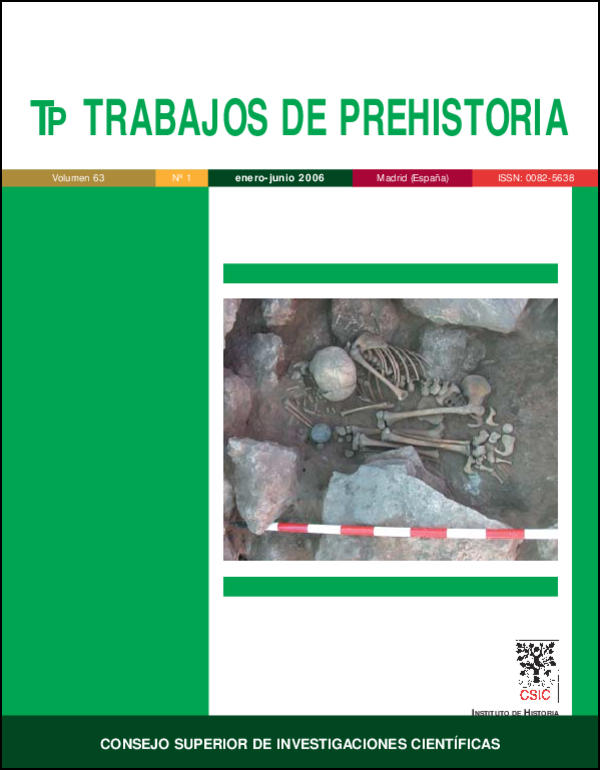A singular children burial from the Bronce Age site of La Motilla del Azuer (Daimiel, Ciudad Real)
DOI:
https://doi.org/10.3989/tp.2006.v63.i1.9Keywords:
Bronze Age, Funerary ritual, ChildhoodAbstract
A child burial with special grave-goods belonging to the Bronze Age is presented. Very small items manufactured in pottery and clay reproduce the typical forms of the materials documented in the settlement.
Downloads
References
Aranda Jiménez, G. y Molina González, F. 2005: “Intervenciones arqueológicas en el yacimiento de la Edad del Bronce del Cerro de la Encina (Monachil, Granada)”. Trabajos de Prehistoria 62: 165- 180.
Aranda Jiménez, G. y Molina González, F. 2006: “Wealth and power in the Bronze Age of Southeast of the Iberian Peninsula: The funerary record of Cerro de la Encina”. Oxford Journal of Archaeology 25(1): 47-59. doi:10.1111/j.1468-0092.2006.00248.x
Baxter, J.E. 2005: The archaeology of childhood. Altamira Press: Walnut Creek
Chapa, T. 2003: “La percepción de la infancia en el mundo ibérico”. Trabajos de Prehistoria 60:115-138.
Finlay, N. 1997: “Kid knapping: the missing children in lithic analysis”. En J. Moore y E. Scott (eds.): Invisible People and Proccess: Writing Gender and Childhood into European Archaeology. Leicester University Press. Londres: 203-212.
Jimenez Brobeil, S.; Al-Oumaoui, I.; Nájera, T. y Molina, F.(e. p.): “Salud y enfermedad en la Motilla del Azuer. Una población de la Edad del Bronce en la Mancha”. Revista Española de Antropología Física 26.
Kamp, K. A. 2001: “Where have all the children gone?: the archaeology of childhood”. Journal of Archaeological Method and Theory 8(1): 1-34. doi:10.1023/A:1009562531188
Kamp, K. A.; Timmerman, N.; Lind, G.; Graybill, J. y Natowsky, I. 1999: “Discovering childhood: using fingerprints to find children in the archaeological record”. American Antiquity 64(2): 309-315. doi:10.2307/2694281
Lillehammer, G. 1989: “A Child is born. The Child’s World in an Archaeological Perspective”. Norwegian Archaeological Review 22(2): 89-105.
Molina, F.; Nájera, T.; Aranda, G., Sánchez, M. y Haro, M. 2005: “Recent fieldwork at the Bronze Age fortified site of Motilla del Azuer (Daimiel, Spain)”. Antiquity 79(306). http://antiquity.ac.uk/ProjGall/306.html.
Nájera Colino, T. 1984: La Edad del Bronce en La Mancha occidental. Tesis Doctorales de la Universidad de Granada 458. Granada.
Nájera, T. y Molina, F. 2004a: “La Edad del Bronce en La Mancha: problemática y perspectivas de la investigación”. En L. Hernández y M. Hernández (eds.): La Edad del Bronce en tierras levantinas y zonas limítrofes. Ayuntamiento de Villena. Alicante: 531-540.
Nájera, T. y Molina, F. 2004b: “Las Motillas. Un modelo de asentamiento con fortificación central en la llanura de La Mancha”. En Mª.R. García Huerta y J. Morales Hervás (coords.): La Península Ibérica en el II milenio a.C.: Poblados y fortificaciones. Ciudad Real: 173-214.
Politis, G. 1998: “Arqueología de la infancia: una perspectiva etnoarqueológica”. Trabajos de Prehistoria 55: 5-19.
Sánchez Romero, M. 2004: “Children in south east of Iberian Peninsula during Bronze Age”. Ethnographisch- Archäologische Zeitschrift 45: 377-387.
Sofaer, J. (ed.) 2000: Children and material culture. Routledge. Londres.
Wileman, J. 2005: Hide and seek. The archaeology of childhood. Tempus. Stroud.
Downloads
Published
How to Cite
Issue
Section
License
Copyright (c) 2006 Consejo Superior de Investigaciones Científicas (CSIC)

This work is licensed under a Creative Commons Attribution 4.0 International License.
© CSIC. Manuscripts published in both the print and online versions of this journal are the property of the Consejo Superior de Investigaciones Científicas, and quoting this source is a requirement for any partial or full reproduction.
All contents of this electronic edition, except where otherwise noted, are distributed under a Creative Commons Attribution 4.0 International (CC BY 4.0) licence. You may read the basic information and the legal text of the licence. The indication of the CC BY 4.0 licence must be expressly stated in this way when necessary.
Self-archiving in repositories, personal webpages or similar, of any version other than the final version of the work produced by the publisher, is not allowed.















